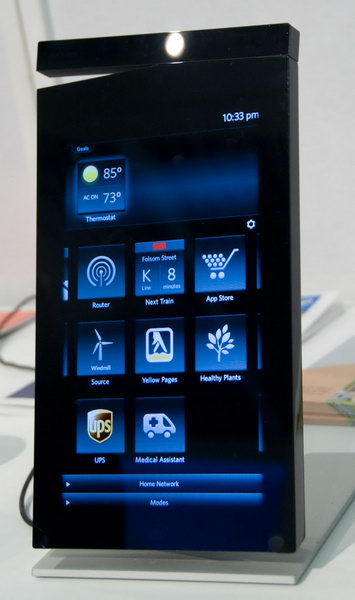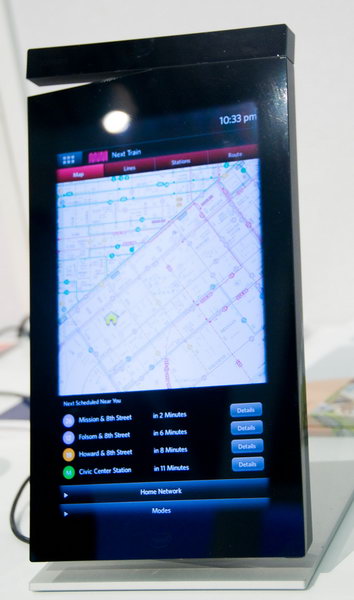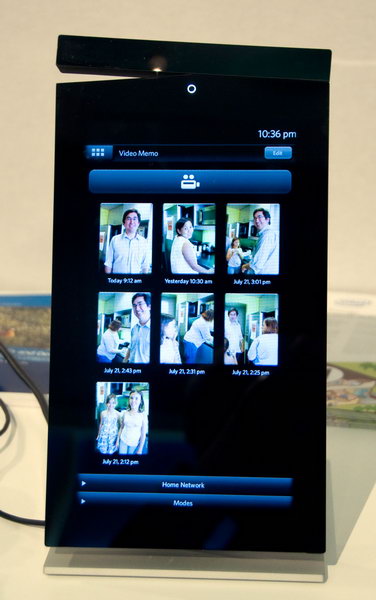Will smart homes of the future be built on the basis of Intel Atom?
The theme of the so-called “smart homes” began to be actively circulated ten years ago. By the standards of the IT industry, this is very, very much. At one time, it began to seem that soon the idea would go to the masses - is it a joke, even in Russia two monthly publications began to be published, where the charms of the intellectualization of housing were signed. However, soon everything died out, magazines were closed, and smart homes remained in science fiction films and novels? Why did it happen so? After all, it is difficult to find a person who would not want to settle a moderate intellectual system in his home walls that helps him to live and work. The reasons, in my opinion, are very simple.
As at the dawn of the development of the computer industry, many very different systems were released - of course, incompatible with each other. They, in turn, are equipped with their own interfaces, so a variety of sensors and expansion modules from one system will not fit the other even with the help of the soldering iron sorcerer and the Fairy of Such-To-Mother. The price of developing systems and sensors is high, the market is small, as a result, you have to take it to the fullest from each buyer, otherwise the costs will not pay off.
Further more. Suppose that the most sophisticated system is installed in a house or apartment that controls all-all-all and is currently the most advanced. But the house does not cost ten years, not twenty. And the filling in it is constantly changing. For example, you decide to change the audio system, and suddenly you find that the new one does not want to be remotely controlled, it is not compatible, s. They decided to put video surveillance in color instead of black and white, and opa - the same problem. Finally, the central module itself got sick, clawed, darkened, and after about five years I wanted to change it to a new one. Oh, for the company, please change all the sensors and modules, well, or stay on the system of the same brand. With localization in general, the seams: to make quality is very expensive and troublesome, but from cheap wealthy customers will spit ...
In general, expensive entertainment is obtained. Very expensive. And therefore, really smart homes are extremely rare and more and more in Japanese and English-speaking countries, and under their guise they advertise remote control of a warm floor, switches that light up when receiving SMS and even acoustics for a home theater with wireless rear speakers. It’s fun, funny, but there’s no relation to the smart home, as we know it from books and films.
However, the situation may soon change. It would seem, where does the Intel Atom? :)
Let's take a look at this photo together.

Personally, I immediately had an association with a weather station, which has long been at my place. Good thing - no need to look out the window to find out the temperature in the street. And what about weather forecasts is lying regularly, so it is only AccuWeather more or less accurate.
But in the picture, The Intel Home Dashboard Concept is a prototype of the digital home control center of the near future. He was shown live at the World Congress on IT, held last week in Amsterdam. Incidentally, in the presence of Intel CEO Paul Otellini.
The machine is so smart that it’s easier to say what it certainly doesn’t know how to walk the dog and take the children out of school. But it’s easy to get the best route for both.

The system also constantly monitors the consumption of electricity, gas and water, while simultaneously monitoring various changes at the supplier companies. For example, the promotion “15% discount from 23 to 6 hours” appeared, and Home Dashboard will immediately inform the owner about this, offering to connect to it with one click. Has a pipe cracked somewhere and increased water consumption? Home Dashboard will control this too. Climate control work, air quality control, traffic information, keeping an eye on children and their nannies, tracking the path of purchases in online stores, sending and receiving emails ...

There is also a client for Intel AppUp , from where purchased applications will go to computers and smartphones registered in the home network.
The functionality of the system can be expanded almost indefinitely, because it supports the entire standard set of modern wired and wireless interfaces. I emphasize - standard interfaces found in all computer and near-computer technology. Their speed for domestic needs will last for a very long time, and if it suddenly ceases to be enough, you can replace the Home Dashboard itself and some of the sensors, and let the rest work thanks to backward compatibility, without which there is nowhere in the PC world.

Using the built-in camera, speakers and a microphone (more precisely, even several microphones - they can be connected additionally, just like cameras), you can see and hear what is happening at home from anywhere in the world and, moreover, respond to what is happening. For example, turning on the siren and arranging the illumination in all rooms, if someone decides to play the home server admin without asking.

And all this works on the Intel Atom Z530 processor, so even in conjunction with an 11.6-inch OLED touchscreen, the cost is very low. And sensors and expansion modules, thanks to standard interfaces, can be done by almost everyone who wants it - as now you do not need the highest permission in order to do something with USB support. And the central unit in different variations can be assembled next to laptops and communicators - the components are all the same, by and large. As for the operating system, there is no information yet, but it looks like Moblin / MeeGo, and given that the inside is quite standard, the scope for experimentation is huge.
In autumn, the first test implementations of Home Dashboard should begin, and if Taiwanese manufacturers like the results, one can expect quite real devices surrounded by a set of various sensors and expansion modules. The latter can really be a great many: I was particularly pleased with the ability to automatically control solar panels on the roof and monitor the level of humidity in the pots of domestic plants. I’ll buy a solar panel and flowers ...
It’s clear that many functions (if not the majority) in Russia are not very realizable (I see how Mosenergo invents discount programs and transmits information about them to the Internet). But to me, as a person constantly wandering around on business trips, such a quiet electronic attendant at home would be very useful. Especially if for the money.
And the last one. Demonstrating the ability to use the x86 architecture in “smart homes”, of course, is not enough for success. Well, if few people believed in communicators on Intel Atom until recently, then home control systems are generally another opera, where the names of soloists hardly say anything to computer scientists. At the same time, no one says that the mass market should be mastered only by the old guard. Who will do better and cheaper, and slippers.
And here, it seems, it turns out better and cheaper at the same time.
As at the dawn of the development of the computer industry, many very different systems were released - of course, incompatible with each other. They, in turn, are equipped with their own interfaces, so a variety of sensors and expansion modules from one system will not fit the other even with the help of the soldering iron sorcerer and the Fairy of Such-To-Mother. The price of developing systems and sensors is high, the market is small, as a result, you have to take it to the fullest from each buyer, otherwise the costs will not pay off.
Further more. Suppose that the most sophisticated system is installed in a house or apartment that controls all-all-all and is currently the most advanced. But the house does not cost ten years, not twenty. And the filling in it is constantly changing. For example, you decide to change the audio system, and suddenly you find that the new one does not want to be remotely controlled, it is not compatible, s. They decided to put video surveillance in color instead of black and white, and opa - the same problem. Finally, the central module itself got sick, clawed, darkened, and after about five years I wanted to change it to a new one. Oh, for the company, please change all the sensors and modules, well, or stay on the system of the same brand. With localization in general, the seams: to make quality is very expensive and troublesome, but from cheap wealthy customers will spit ...
In general, expensive entertainment is obtained. Very expensive. And therefore, really smart homes are extremely rare and more and more in Japanese and English-speaking countries, and under their guise they advertise remote control of a warm floor, switches that light up when receiving SMS and even acoustics for a home theater with wireless rear speakers. It’s fun, funny, but there’s no relation to the smart home, as we know it from books and films.
However, the situation may soon change. It would seem, where does the Intel Atom? :)
Let's take a look at this photo together.

Personally, I immediately had an association with a weather station, which has long been at my place. Good thing - no need to look out the window to find out the temperature in the street. And what about weather forecasts is lying regularly, so it is only AccuWeather more or less accurate.
But in the picture, The Intel Home Dashboard Concept is a prototype of the digital home control center of the near future. He was shown live at the World Congress on IT, held last week in Amsterdam. Incidentally, in the presence of Intel CEO Paul Otellini.
The machine is so smart that it’s easier to say what it certainly doesn’t know how to walk the dog and take the children out of school. But it’s easy to get the best route for both.

The system also constantly monitors the consumption of electricity, gas and water, while simultaneously monitoring various changes at the supplier companies. For example, the promotion “15% discount from 23 to 6 hours” appeared, and Home Dashboard will immediately inform the owner about this, offering to connect to it with one click. Has a pipe cracked somewhere and increased water consumption? Home Dashboard will control this too. Climate control work, air quality control, traffic information, keeping an eye on children and their nannies, tracking the path of purchases in online stores, sending and receiving emails ...

There is also a client for Intel AppUp , from where purchased applications will go to computers and smartphones registered in the home network.
The functionality of the system can be expanded almost indefinitely, because it supports the entire standard set of modern wired and wireless interfaces. I emphasize - standard interfaces found in all computer and near-computer technology. Their speed for domestic needs will last for a very long time, and if it suddenly ceases to be enough, you can replace the Home Dashboard itself and some of the sensors, and let the rest work thanks to backward compatibility, without which there is nowhere in the PC world.

Using the built-in camera, speakers and a microphone (more precisely, even several microphones - they can be connected additionally, just like cameras), you can see and hear what is happening at home from anywhere in the world and, moreover, respond to what is happening. For example, turning on the siren and arranging the illumination in all rooms, if someone decides to play the home server admin without asking.

And all this works on the Intel Atom Z530 processor, so even in conjunction with an 11.6-inch OLED touchscreen, the cost is very low. And sensors and expansion modules, thanks to standard interfaces, can be done by almost everyone who wants it - as now you do not need the highest permission in order to do something with USB support. And the central unit in different variations can be assembled next to laptops and communicators - the components are all the same, by and large. As for the operating system, there is no information yet, but it looks like Moblin / MeeGo, and given that the inside is quite standard, the scope for experimentation is huge.
In autumn, the first test implementations of Home Dashboard should begin, and if Taiwanese manufacturers like the results, one can expect quite real devices surrounded by a set of various sensors and expansion modules. The latter can really be a great many: I was particularly pleased with the ability to automatically control solar panels on the roof and monitor the level of humidity in the pots of domestic plants. I’ll buy a solar panel and flowers ...
It’s clear that many functions (if not the majority) in Russia are not very realizable (I see how Mosenergo invents discount programs and transmits information about them to the Internet). But to me, as a person constantly wandering around on business trips, such a quiet electronic attendant at home would be very useful. Especially if for the money.
And the last one. Demonstrating the ability to use the x86 architecture in “smart homes”, of course, is not enough for success. Well, if few people believed in communicators on Intel Atom until recently, then home control systems are generally another opera, where the names of soloists hardly say anything to computer scientists. At the same time, no one says that the mass market should be mastered only by the old guard. Who will do better and cheaper, and slippers.
And here, it seems, it turns out better and cheaper at the same time.
